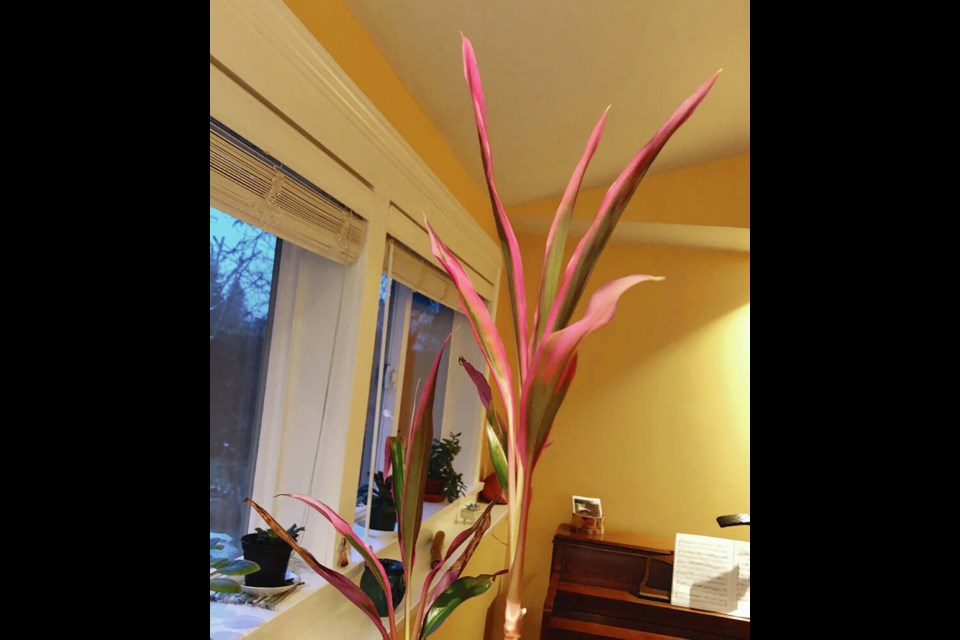As I arrived at a friend’s home one late summer day last year, I was surprised to see a new plant on her patio. It was a Dracaena marginata with three slender stems, each a different height and topped by tufts of foliage. The plant was a gift from friends who had no suitable place for it in their new home.
My mind immediately slipped into creative mode as I imagined the possibilities presented by the Daracaena. I imagined a comfortable chair and a table set beside the tall, tropical looking plant, perhaps with several bushier potted plants around it. Marilyn already had a line of flowering plants atop a concrete wall on the far side of the patio. I saw a little summer oasis of lush greenery, a lightly shaded place of calm and repose.
I stopped by Marilyn’s home a few times more in the summer and early autumn, each time admiring the plant and allowing it to inspire little “garden of Eden” scenes in my imagination.
Then, in November, an email alerted me to problems in Dracaena paradise. Could I come by and offer some advice? After the plant was brought indoors at the end of October, leaves began dropping and the remaining leaves were turning brown at the tips. The plant was obviously displaying its displeasure at being left outdoors too long and the shock of an abrupt move from damp, cold conditions into a well-heated room and dry air.
Fortunately, Dracaena marginata is one of the more tough and resilient Dracaenas. I was sure, with a few tweaks, the damage could be reversed and the plant restored to its potential splendour.
The plant had been placed just inside the door from the patio, by the wall on the dark side of a sitting room. My first suggestion was to move the plant into better light, in a corner beside a row of windows across the far wall where other, smaller plants were flourishing.
Next came the watering. With Marilyn’s permission, I poked a finger into the pot’s soil and could feel moisture just beneath the surface. That was just right. The soil needs to be kept moist, but with less water in winter than in spring through mid-autumn. A slightly dried surface with modest moisture underneath is perfect.
I suggested giving the leaves a very light misting, in the early part of the day. to counter the dryness of the heated air. Finally, giving the plant a quarter turn (in the same direction) weekly would help to keep the long stems straight.
I soon received word that fresh leaves were appearing, though the older, outer leaves were dried and bedraggled. Slowly, the plant took on new life. By early January, most of the dried bits had been cleaned away, to be replaced with vibrant green and red foliage. A sturdy little shoot had begun growing from low down on the thickest stem. The plant was on a roll.
As more shoots grow from the Dracaena’s slender stems, Marilyn will have a plethora of choices when spring pruning time comes around. She may choose to shorten a stem by cutting it off just above where a new shoot has emerged. She may opt to cut the thinnest stem down close to the soil lime, where it will grow a tuft of new leaves as a colourful underpinning for the taller growth.
The tip of a removed stem can be inserted into a potting mix and rooted to make a new plant. Potted stem sections will also sprout to create new plants.
Dracaena marginata, commonly called Dragon Tree, is one of the easiest house plants to care for. Several beautiful forms of this plant exist and are often seen where house plants are sold
VHS meeting. The Victoria Horticultural Society is hosting a Zoom meeting on Tuesday, Feb. 1, from 7 to 8:30 p.m. The featured speaker will be Karl Gercens, conservatory manager at Longwood Gardens, Pennsylvania. He is currently working on their display gardens, including a new Mediterranean-inspired landscape opening in 2024. He is also a noted garden photographer. His topic will address our sub-Mediterranean Victoria climate: Pushing the Limits! Plant selection and design inspired by gardens in Australia, New Zealand and the British Isles.” Drop-in fee for non-members is $5. To register, visit the Victoria Horticultural Society website



